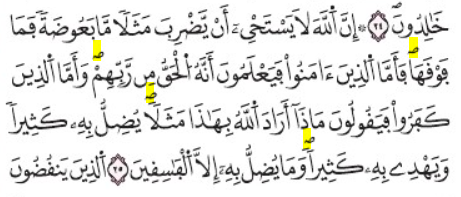First of all I'm not too familiar with the riwaya of Hafs and the middle eastern and their alike (i.e. Turkish/Pakistani) waqf signs.
Therefore I'll rely on the answers given in:
What are the different punctuation in Quran?
Basically waqf can be performed when the meaning of the sentence is clear or the statement makes sense: In other words the sentence is complete.
Let's divide your quote into waqf options (I've deleted the waqf signs in the quotes themselves), I'll add the Sahih International translation including the punctuation to your quotes:
إِنَّ ٱللَّهَ لَا يَسْتَحْىِۦٓ أَن يَضْرِبَ مَثَلًۭا مَّا بَعُوضَةًۭ فَمَا فَوْقَهَا
Indeed, Allah is not timid to present an example - that of a mosquito or what is smaller than it.
This part of the verse was succeeded by the ۚ sign which indicates a permissible waqf as stated in the answers of مجاهد and Jamila see also other answers like that of System down, but I've quoted the first two here only:
(ج) Jeem: It means you are able to stop if you want.
ج Jeem: it is allowed waqf (the similar as in the Egyptian standard).
فَأَمَّا ٱلَّذِينَ ءَامَنُوا۟ فَيَعْلَمُونَ أَنَّهُ ٱلْحَقُّ مِن رَّبِّهِمْ
And those who have believed know that it is the truth from their Lord.
This part is succeeded by the ۖ sign according to which you are free to perform waqf or continue, but continuing is regarded as better again see the answers of مجاهد and System down in the above post:
(صلي): Means you can stop or continue on, but continuing on is more prefered than stopping.
(صلى) It is better to continue (mustahab), but you may stop (ja'iz).
وَأَمَّا ٱلَّذِينَ كَفَرُوا۟ فَيَقُولُونَ مَاذَآ أَرَادَ ٱللَّهُ بِهَـٰذَا مَثَلًۭا
But as for those who disbelieve, they say, "What did Allah intend by this as an example?"
This part is succeeded by the ۘ sign, which indicates a stop which is mandatory or necessary, as stated in the different answers on the post linked above here shortly the quotes from مجاهد and Jamila's answers :
(م) Meem: When seen, it means you must stop, it is a mandatory stop. Mind you, you will also see a meem After a Noon Sakin or a Tanwin which means that the rule of Iqlab is to be applied. You will see a Baa' after it, if you see no Baa' than there is no Iqlab.
م Meem: for a mandatory waqf (pause).
يُضِلُّ بِهِۦ كَثِيرًۭا وَيَهْدِى بِهِۦ كَثِيرًۭا
He misleads many thereby and guides many thereby.
This part is again succeeded by the ۚ sign.
وَمَا يُضِلُّ بِهِۦٓ إِلَّا ٱلْفَـٰسِقِينَ
And He misleads not except the defiantly disobedient,
Here the "," in the translation may indicate that it is permissible to go ahead and continue, however the choice -as stated by many scholars- of the qorraa' was to stop or have a small pause at the end of a verse.
Here again the same verse in the Moshaf of al-Madina with the pause/waqf signs highlighted

And for the purpose of comparison the same verse with the waqf signs which are mainly used in north African Moshafs

In other words you may recite this verse in one of the following ways:
- You could stop at all possible waqf signs-> 4 stops + stop at the end of the verse. This would be the easiest option and it is conform to one choice of the scholars (see north African stop signs).
- You could stop there were waqf is mandatory or recommended but continuing is not the better choice -> 3 stops + at the end of the verse:
(stop after) إِنَّ ٱللَّهَ لَا يَسْتَحْىِۦٓ أَن يَضْرِبَ مَثَلًۭا مَّا بَعُوضَةًۭ فَمَا فَوْقَهَا
(continue after) فَأَمَّا ٱلَّذِينَ ءَامَنُوا۟ فَيَعْلَمُونَ أَنَّهُ ٱلْحَقُّ مِن رَّبِّهِمْ
(stop after) وَأَمَّا ٱلَّذِينَ كَفَرُوا۟ فَيَقُولُونَ مَاذَآ أَرَادَ ٱللَّهُ بِهَـٰذَا مَثَلًۭا
(stop after) يُضِلُّ بِهِۦ كَثِيرًۭا وَيَهْدِى بِهِۦ كَثِيرًۭا
وَمَا يُضِلُّ بِهِۦٓ إِلَّا ٱلْفَـٰسِقِينَ
- If you have long breath you could read it with one stop only:
إِنَّ ٱللَّهَ لَا يَسْتَحْىِۦٓ أَن يَضْرِبَ مَثَلًۭا مَّا بَعُوضَةًۭ فَمَا فَوْقَهَا ۚ فَأَمَّا ٱلَّذِينَ ءَامَنُوا۟ فَيَعْلَمُونَ أَنَّهُ ٱلْحَقُّ مِن رَّبِّهِمْ ۖ وَأَمَّا ٱلَّذِينَ كَفَرُوا۟ فَيَقُولُونَ مَاذَآ أَرَادَ ٱللَّهُ بِهَـٰذَا مَثَلًۭا ۘ
(Stop here then recite)
يُضِلُّ بِهِۦ كَثِيرًۭا وَيَهْدِى بِهِۦ كَثِيرًۭا ۚ وَمَا يُضِلُّ بِهِۦٓ إِلَّا ٱلْفَـٰسِقِينَ
- You may chose any of the recommended stop options but stop at the mandatory stop based on how long you could hold your breath the options here are rather various.


